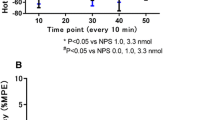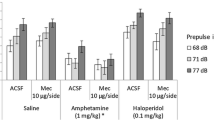Abstract
Previous research has shown that repeated daily pretreatment with the opiate receptor blocker naloxone retards the development of habituation to novelty-induced hypoalgesia. The present experiments were conducted in order to determine whether noradrenergic substrates mediate this effect. Animals in the NAL condition were administered 10 mg/kg naloxone prior to assessment of pain sensitivity on a 48.5° C hot plate. Control animals (SAL condition) were administered saline prior to pain assessment, and naloxone 2–4 h later. Paw lick latencies declined over repeated tests in SAL animals, suggesting the habituation of novelty hypoalgesia. Naloxone pretreatment attenuated this decline. The longer paw lick latencies observed in NAL condition animals were reduced by administration of 2 µg/kg clonidine, a specific noradrenergic alpha-2 receptor agonist, and enhanced in a dose dependent (0.5–4.0 mg/kg) fashion by the alpha-2 antagonist yohimbine. Clonidine and yohimbine either failed to alter pain reactivity in control animals, or produced less marked effects than those observed in naloxone-exposed animals. These results suggest that noradrenergic substrates mediate naloxone's effects on novelty hypoalgesia.
Similar content being viewed by others
References
Abbott FV, Franklin KBJ, Connell B (1986) The stress of a novel environment reduces formalin pain: possible role of serotonin. Eur J Pharmacol 126:141–144
Abercrombie ED, Jacobs BL (1988) Systemic naloxone administration potentiates locus coeruleus noradrenergic neuronal activity under stressful but not non-stressful conditions. Brain Res 441:362–366
Anden NE, Corrodi H, Fuxe K, Hokfelt T, Rydin C, Svensson T (1970) Evidence for a central NA receptor stimulation by clonidine. Life Sci 2:513–523
Bardo MT, Hughes RA (1979) Exposure to a nonfunctional hot plate as a factor in the assessment of morphine-induced analgesia and analgesic tolerance. Pharmacol Biochem Behav 10:481–485
Bodnar RJ, Merrigan KP, Sperber E (1983) Potentiation of cold water swim analgesia and hypothermia by clonidine. Pharmacol Biochem Behav 19:447–451
Bodnar RJ, Mann PE, Stone FA (1985) Potentiation of cold water swim analgesia by acute, but not chronic desipramine treatment. Pharmacol Biochem Behav 23:749–752
Bricca G, Dontenwill M, Molines A, Feldman J, Belcourt A, Bousquet P (1989) The imidazoline preferring receptor: binding studies in bovine, rat and human brainstem. Eur J Pharmacol 162:1–9
Brown CM, MacKinnon AC, McGrath JC, Spedding M, Kilpatrick AT (1990) Alpha 2-adrenoceptor subtypes and imidazoline-like binding sites in the rat brain. Br J Pharmacol 99:803–809
Chance WL (1986) The role of brain and spinal cord norepinephrine in autoanalgesia. Ann NY Acad Sci 467:309–330
Chance WL Schechter WD (1979) Autoanalgesia: blockade by yohimbine. Eur J Pharmacol 58:89–90
Clark RD, Berger J, Garg P, Weinhardt RK, Spedding M, Kilpatrick AT, Brown CM, MacKinnon AC (1990) Affinity of 2-(tetrahydroisoquinolin-2-ylmethyl)- and 2-(isoindolin-2-ylmethyl)imidazolines for alpha-adrenoceptors. Differential affinity of imidazolines for the [3H]idazoxan-labeled alpha 2-adrenoceptor vs the [3H]yohimbine-labeled site. J Med Chem 33:596–600
Coderre TJ, Rollman GB (1984) Stress analgesia: effects of PCPA, yohimbine and naloxone. Pharmacol Biochem Behav 21:681–686
Dahlstrom A, Fuxe K (1964) Evidence for the existence of monoamine containing neurons in the central nervous system. I. Demonstrations of monoamines in the cell bodies of brainstem neurons. Acta Physiol Scand 62:1–55
Dubocovich ML (1984) Presynaptic alpha-adrenoreceptors in the central nervous system. Ann NY Acad Sci 420:7–25
Feldman J, Tibirica E, Bricca G, Dontenwill M, Belcourt A, Bousquet P (1990) Evidence for the involvement of imidazoline receptors in the central hypotensive effect of rilmenidine in the rabbit. Br J Pharmacol 100:600–604
Gamble GD, Milne RJ (1989) Repeated exposure to sham testing procedures reduces reflex withdrawal and hot-plate latencies: attenuation of tomic descending inhibition? Neurosci Lett 96:312–317
Greeley JD, Le AD, Poulos CX, Cappell H (1988) “Paradoxical” analgesia induced by naloxone and naltrexone. Psychopharmacology 96:36–39
Hamon MD, Collin E, Chantrel D, Verge D, Bourgoin S (1991) The contribution of monoamines and their receptors to pain control. In Basbaum AI, Besson JM (eds) Towards a new pharmacotherapy of pain. Wiley, New York, pp 83–102
Howe JR, Yaksh TL (1982) Changes in sensitivity to intrathecal norepinephrine and serotonin after 6-hydroxydopamine (6-OH-DA), 5,6-dihydroxytryptamine (5,6-DHT) or repeated monoamine administration. J Pharmacol Exp Ther 220:311–321
Illes P, Norenberg W (1990) Blockade of alpha-2 adrenoreceptors increases opioid mu-receptor-mediated inhibition of firing rate of rat locus coeruleus neurones. Naunyn-Schmiedeberg's Arch Pharmacol 342:490–496
Karege F, Gaillard JM (1990) Metabolism time-course of monoamines in rat brain after low dose of clonidine. Biogenic Amines 7:37–48
Kepler RL, Bodnar RJ (1988) Yohimbine potentiates cold water swim analgesia: re-evaluation of a noradrenergic role. Pharmacol Biochem Behav 29:83–88
Kirchgessner AL, Bodnar RJ, Pasternak GW (1982) Naloxazone and paininhibitory systems: evidence for a collateral inhibition model. Pharmacol Biochem Behav 17:1175–1179
Krulich L, Jurcovicova J, Le T (1989) Prolactin (PRL) release-inhibiting properties of the alpha 2 adrenergic receptor antagonist idazoxan: comparison with yohimbine. Life Sci 44:809–818
Lachaud V, Coupry I, Podevin RA, Koenig E, Parini A (1989) Selectivité des agonistes alpha 2-adrenergiques pour les recepteurs imidazolinique-guanidiniques et alpha 2-adrenergiques. Arch Mal Coeur 82:1135–1137
Michel MC, Brodde OE, Schnepel B, Behrendt J, Tschada R, Motulsky HJ, Insel PA (1989) [3H]idazoxan and some other alpha 2-adrenergic drugs also bind with high affinity to a non-adrenergic site. Mol Pharmacol 35:324–330
Montel H, Starke K, Weber F (1974) Influence of morphine and naloxone on release of noradrenaline from rat brain cortex slices. Naunyn-Schmiedeberg's Arch Pharmacol 283:357–369
Paalzow G, Paalzow L (1976) Clonidine antinociceptive activity: effect of drugs influencing central monoaminergic and cholinergic mechanisms in the rat. Naunyn-Schmiedeberg's Arch Pharmacol 292:119–126
Piletz JE, Andorn AC, Unnerstall JR, Halaris A (1991) Binding of [3H]-p-aminoclonidine to alpha 2-adrenoceptor states plus a non-adrenergic site on human platelet plasma membranes. Biochem Pharmacol 42:569–584
Rochford J, Stewart J (1987) Activation and expression of endogenous pain control mechanisms in rats given repeated nociceptive tests under the influence of naloxone. Behav Neurosci 101:87–103
Ruffolo RR Jr, DeMarinis RM, Wise M, Hieble JP (1988) Structure-activity relationships for alpha-2 adrenergic agonists and antagonists. In: Limbird LM (ed) The alpha-2 adrenergic receptors. Humana Press, Clifton, NJ, pp 115–186
Sagen J, Proudfit HK (1981) Hypoalgesia induced by blockade of noradrenergic projections to the raphe magnus: reversal by blockade of noradrenergic projections to the spinal cord. Brain Res 223:391–396
Sagen J, Proudfit HK (1985) Evidence for pain moulation by pre- and postsynaptic noradrenergic receptors in the medulla oblongata. Brain Res 331:285–293
Sawynok J, Reid A (1986) Role of ascending and descending noradrenergic pathways in the antinociceptive effect of baclofen and clonidine. Brain Res 386:341–350
Sherman JE (1979) The effects of conditioning and novelty on the rats' analgesic and pyretic response to morphine. Learn Motiv 10:381–418
Tanaka M, Kohno Y, Nakagawa R, Ida Y, Iimori K, Hoaki Y, Tsuda A, Nagasaki N (1982) Naloxone enhances stress-induced increases in noradrenaline turnover in specific brain regions in rats. Life Sci 30:1663–1669
Tibirica E, Feldman J, Mermet C, Gonon F, Bousquet P (1991) An imidazoline-specific mechanism for the hypotensive effect of clonidine: a study with yohimbine and idazoxan. J Pharmacol Exp Ther 256:606–613
Ungerstedt U (1971) Stereotaxic mapping of monoamine pathways in the rat brain. Acta Physiol Scand 367:1–48
Westbrook RF, Greeley JD (1990) Some effects of the opioid antagonist, naloxone, upon the rat's reactions to a heat stressor. Q J Exp Psychol 42B:1–40
Winer BJ (1971) Statistical principles in experimental design, 2nd edn. McGraw Hill, New York
Author information
Authors and Affiliations
Rights and permissions
About this article
Cite this article
Rochford, J., Dawes, P. Clonidine and yohimbine modulate the effects of naloxone on novelty-induced hypoalgesia. Psychopharmacology 107, 575–580 (1992). https://doi.org/10.1007/BF02245273
Received:
Revised:
Issue Date:
DOI: https://doi.org/10.1007/BF02245273




